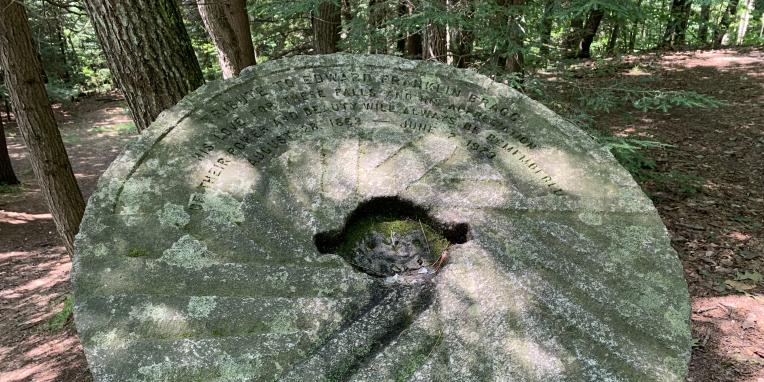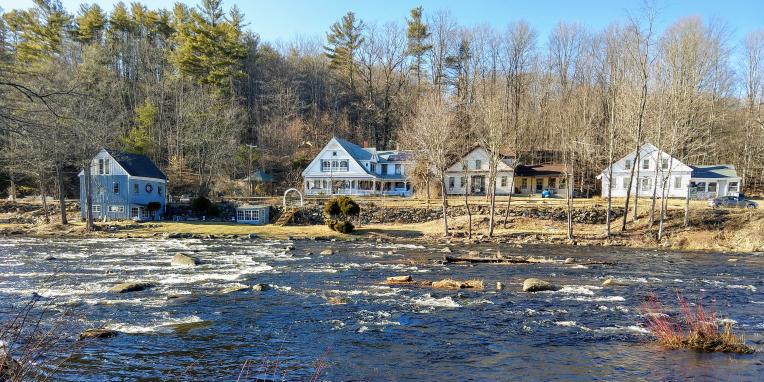Historic District Bylaw
Historic District Bylaw
Royalston, Massachusetts
- Section I Bylaw Premise
- Section II District Boundaries
- Section III Commission Organization and Powers
- Section IV Enforcement and Penalties
- Section V Appeals
- Section VI Bylaw Amendments
Section I
Purposes and Validity
The purpose of this by-law is to promote the educational, cultural, economic and general welfare of the public through the preservation and protection of the distinctive characteristics of buildings and places significant in the history of Royalston, or significant for their architecture, and the maintenance and improvement of settings for such buildings and places and the encouragement of design compatible therewith.
For the purposes and reasons as set forth in the Massachusetts General Laws Chapter 40C, as most recently amended, hereinafter cited as the HISTORIC DISTRICTS ACT; except for the ordinary maintenance, repair or replacement of any exterior architectural feature which does not involve a change in design, material, color or the outward appearance thereof, landscaping with plants, trees, or shrubs, or meeting requirements certified by a duly authorized public officer to be necessary for public safety because of unsafe or dangerous condition, no building or structure within the historic district shall be constructed or altered in any way that affects its exterior features unless the Royalston Historic District Commission shall first have issued a certificate of appropriateness, a certificate of non-applicability or a certificate of hardship with respect to such construction or alteration.
The provisions of this by-law shall be deemed to be severable. If any of its provisions shall be held to be invalid or unconstitutional by any court of competent jurisdiction, the remaining provisions shall continue in full force and effect.
In case of any conflict between the wording of this text and the Massachusetts General Laws, the Massachusetts General Laws shall govern.
Where this by-law imposes a greater control upon setback, signs and other external features than is imposed by other by-laws of the Town of Royalston, the provisions of this by-law shall govern.
Section II
Historic District Boundaries
The location and boundaries of this district are hereby established as shown on a map entitled "Historic District Map of the Town of Royalston" dated January 1979. (on file in Town Clerk's Office)
Section III
Membership
There is hereby established under Chapter 40C of the General Laws an Historic District Commission consisting of seven members and three alternate members, appointed by the Board of Selectmen, including one member, where possible, from two nominees submitted by the Royalston Historical Society, one member, where possible, from two nominees, one of whom shall be submitted by the Massachusetts State Chapter of the American Institute of Architects, and one member, where possible, from two nominees of the Board of Realtors covering Royalston. Where possible one or more of the members shall be a resident of an Historic District established in Royalston pursuant to the Historic Districts Act.* When the Commission is first established, two members and one alternate shall be appointed for one year, two members and one alternate shall be appointed for two years, and three members and one alternate shall be appointed for three years. Successors shall each be appointed for a term of three years. Vacancies shall be filled within 60 days by the Board of Selectmen by appointment for the unexpired term. In the case of absence, inability to act, or unwillingness to act because of self-interest by a member, the Chairman shall designate an alternate member of the Commission to act for a specified time. All members shall serve without compensation. The Commission shall elect annually a Chairman and Vice-Chairman from its own number and a Secretary from within or without its number.
* Additional membership suggestions: Lawyer, professional historian, additional residents of district, member of Planning Board, member of Conservation Commission, individuals interested in historic preservation.
Meetings
Meetings of the Commission shall be held at the call of the Chairman or shall be called at the request of two (2) members of the Commission or in such other manner as the Commission shall determine in its rules. A majority of the members of the Commission shall constitute a quorum. The concurring vote of a majority of the members of the Commission shall be necessary to issue a certificate of appropriateness, a certificate of non-applicability or a certificate of hardship.
Powers and Duties
In passing upon matters before it, the Commission shall consider, among other things, the historic and architectural value and significance of the site, building or structure, the general design, arrangement, texture, material and color of the features involved, and the relation of such features to similar features of buildings and structures in the surrounding area. In the case of new construction or additions to existing buildings or structures, the Commission shall consider the appropriateness of the size, scale and shape of the same in relation to the land area upon which the building or structure is situated, to adjacent buildings and structures and to buildings and structures and to buildings and structures in the surrounding area.
The Commission may, in appropriate cases, impose dimensional and setback requirements in addition to those required by applicable by-law.
The reconstruction, substantially similar in design of a building, structure or external architectural feature damaged or destroyed by fire, storm or other disaster, must be begun within one year and carried forward with due diligence. If any of the exterior architectural features are changed in the reconstruction plans, then a certificate of appropriateness must be obtained from the Commission. If the structure is damaged beyond repair then the owner will clear area of all debris and complete landscaping to conform with surrounding area within one year.
The Commission may determine from time to time after public hearing that certain categories of exterior architectural features, colors, structures or signs, may be constructed or altered without review by the Commission without causing substantial derogation from the intent and purposes of this chapter.
The Commission may, after public hearing, set forth in such manner as it may determine the various designs of certain appurtenances, such as light fixtures, which will meet the requirements of a historic district and a roster of certain colors of paint and roofing materials which will meet the requirements of a historic district, but no such determination shall limit the right of an applicant to present other designs or colors to the Commission for its approval.
The Commission shall require appropriate drawings to show the nature and extent of proposed construction or alterations. The drawings need not be prepared by an architect.
The Commission may, subject to appropriations, employ clerical and technical assistants or consultants and incur other expenses appropriate to the carrying out of its work, and may accept money gifts and expend same for such purposes. The Commission may administer on behalf of the town any properties or easements, restrictions or other interests in real property which the town may have or may accept as gifts or otherwise and which the town may designate the Commission as the administrator thereof.
The Commission shall have, in addition to the powers, authority and duties granted to it by this bylaw, such other powers, authority and duties as may be delegated or assigned to it from time to time by vote of a town meeting.
The Commission shall keep a permanent record of its resolutions, transactions and determinations and of the vote of each member participating therein, and may adopt and amend such rules and regulations not inconsistent with the provisions of the Historic District Act and prescribe such forms as it shall deem desirable and necessary for the regulation of its affairs and the conduct of its business. The Commission shall file a copy of any such rules and regulations with the Town Clerk.
The Commission should, when it feels a property is being neglected to the detriment of the architectural features of the building, meet with the owner of said property to discuss what steps can be taken.
The Commission shall keep an open mind toward alternative energy features being added to buildings within the district.
The Historic District Commission will act as the Local Historical Commission under the provisions of Massachusetts Chapter 40, Section 8D.
The Commission shall not make any recommendation or requirement except for the purpose of preventing developments incongruous to the historic aspects or the architectural characteristics of the surroundings and of the Historic District.
The Commission shall not consider interior arrangements or architectural features not subject to public view.
The Commission shall not extend its review to temporary signs, banners, streamers or placards or temporary structures approved by special permission of the selectmen.
The Commission shall not extend its review to events e.g. art shows, bazaars, church fairs, which are temporary in nature.
The Commission shall not extend its review to new storm or screen doors and windows installed in existing openings, so as to cover existing doors and windows, respectively, nor to removable porch enclosures, room air conditioners, TV antennas and similar appurtenances except as they are part of new construction, additions or reconstruction.
Section IV
Administration, Enforcement and Penalties
Definitions
As used in this by-law, the word "altered" includes the words "rebuilt", "reconstructed", "restored", "removed", and "demolished", and the phrase "changed in exterior color". The word "building" means a combination of materials forming a shelter for persons, animals or property, the word "Commission" means the commission acting as the Historic District Commission; the word "constructed" includes the words "built", "installed", "enlarged" and "moved"; the words "exterior architectural feature" mean such portion of the exterior of a building or structure as is open to view from a public street, public way, public park or public body of water, including, but not limited to, the architectural style and general arrangement and setting thereof, the kind, color, and texture of exterior building materials, the color of paint or other materials applied to exterior surfaces and the type and style of windows, doors, lights, signs, and other appurtenant exterior fixtures, and the word "structure" means a combination of materials other than a building, including a sign, fence, wall, terrace, walk or driveway. An external exterior architectural feature is still considered open to public view if it would be, otherwise, despite its concealment by existing or newly planted trees shrubs or plants, in consideration of their impermanent nature.
Applications
Any person who desires to obtain a certificate from the Commission shall file with the Commission an application for a certificate of appropriateness, a certificate of nonapplicability or a certificate of hardship, as the case may be, in such form as the Commission may reasonable determine, together with such plans, elevations, specifications, materials and other information, including in the case of demolition or removal a statement of the proposed condition and appearance of the property thereafter, as may be reasonably deemed necessary by the Commission to enable it to make a determination on the application.
Public Hearings
The Commission shall determine promptly, and in all events within fourteen (14) days after the filing of an application for a certificate of appropriateness, a certificate of non-applicability or a certificate of hardship, as the case may be, whether the application involves any exterior architectural features which are subject to approval by the Commission. If the Commission determines that such application involves any such features, the Commission shall hold a public hearing on such application unless such hearing is dispensed with as hereinafter provided.
The Commission shall fix a reasonable time for the hearing on any application and shall give public notice of the time, place and purposes thereof at least fourteen (14) days before said hearing in such manner as it may determine, and by mailing, postage prepaid, a copy of said notice to the applicant, to the owners of all adjoining property and other property deemed by the Commission to be materially affected thereby as they appear on the most recent real estate tax list of the Board of Assessors, to the Planning Board of the Town, to any person filing written request for notice of hearing, such request to be renewed yearly in December and to such other persons as the Commission shall deem entitled to notice.
As soon as convenient after such public hearing, but in any event within sixty (60) days after the filing of such application, or within such further time as the applicant may allow in writing, the Commission shall make a determination on the application. If the Commission shall fail to make a determination within such period of time, the Commission shall thereupon issue a certificate of hardship.
A public hearing on an application need not be held if such hearing is waived in writing by all persons entitled to notice thereof. In addition, a public hearing on an application may be waived by the Commission if the Commission determines that the exterior architectural feature involved or its category or color, as the case may be, is so insubstantial in its effect in the historic district that it may be reviewed by the Commission without public hearing on the application; provided, however, that if the Commission dispenses with a public hearing on an application, notice of the application shall be given to the owners of all adjoining property and other property deemed by the Commission to be materially affected thereby as provided, and ten days shall elapse after the mailings of such notice before the Commission may act upon such application.
Certificate
A. Appropriateness
If the Commission determines that the construction or alteration for which an application for a certificate of appropriateness has been filed will be appropriate for, or compatible with, the preservation or protection of the historic district, the Commission shall cause a certificate of appropriateness to be issued to the applicant. In the case of a disapproval of an application for a certificate of appropriateness, the Commission shall place upon its records the reasons for such determination and shall forthwith cause a notice of its determination, accompanied by a copy of the reasons therefore as set forth in the records of the Commission, to be issued to the applicant, and the Commission may make recommendations to the applicant with respect to appropriateness of design arrangement, texture, material and similar features. Prior to the issuance of any disapproval, the Commission may notify the applicant of its proposed action accompanied by recommendations of changes in the applicants proposal which, if made, would make the application acceptable to the Commission. If, within fourteen (14) days of the receipt of such notice, the applicant files a written modification of his application in conformity with the recommended changes of the Commission, the Commission shall cause a certificate of appropriateness to be issued to the applicant.
B. Non-Applicability
In the case of a determination by the Commission that an application for a certificate of appropriateness or for a certificate of non-applicability does not involve any exterior architectural features, or involves an exterior architectural feature which is not then subject to review by the Commission in accordance with the provisions of Section III, the Commission shall cause a certificate of non-applicability to be issued to the applicant.
C. Hardship
If the construction or alteration for which an application for a certificate of appropriateness has been filed shall be determined to be inappropriate, or in the event of an application for a certificate of hardship, the Commission shall determine whether, owing to conditions especially affecting the building or structures involved, but not affecting the historic district generally, failure to approve an application will involve a substantial hardship, financial or otherwise to the applicant and whether such application may be approved without substantial detriment to the public welfare and without substantial derogation from the intent and purposes of this by-law. If the Commission determines that owing to such conditions, failure to approve an application will involve substantial hardship to the applicant and approval thereof may be made without such substantial detriment or derogation, or in the event of failure to make a determination on an application within sixty (60) days after the filing of the application, the Commission shall cause a certificate of hardship to be issued to the applicant.
Filing
The Commission shall file with the Town Clerk and with the Building Inspector a copy or notice of all certificates and determinations of disapproval issued by it. Each certificate issued by the Commission shall be dated and signed by its chairman, or such other person designated by the Commission to sign such certificates on its behalf
Enforcement
No building permit for construction of a building or structure or for alteration of an exterior architectural feature within the historic district and no demolition permit for demolition or removal of a building or structure within the historic district shall be issued by the Town or any department thereof until the certificate required by this section has been issued by the Commission.
The Worcester Superior Court sitting in equity shall have jurisdiction to enforce the provisions of this by-law, and the determinations, rulings and regulations issued pursuant thereto, and may, upon the petition of the Board of Selectmen or of the Commission, restrain by injunction violations thereof; and, without limitation, such Court may order the removal of any building, structure or exterior architectural feature constructed in violation thereof, or the substantial restoration of any building, structure or exterior architectural feature altered or demolished in violation thereof, and may issue such other orders for relief as may be equitable.
Penalties
Whoever violates any of the provisions of this by-law shall be punished by a fine of not less than ten dollars nor more than five hundred dollars. Each day during any portion of which a violation continues to exist shall constitute a separate offense unless adequate progress is being made toward the correction of the violation.
Section V
Appeals
Any applicant aggrieved by a determination of the Commission, may within twenty (20) days after the filing of the notice of such determination with the Town Clerk, file a written request with the Commission for a review by a person or persons of competence and experience in such matters, designated by the regional planning agency of which the Town is a member. The finding of the person or persons making such review shall be filed with the Town Clerk within forty-five (45) days after the request, and shall be binding on the applicant and the Commission, unless a further appeal is sought in the Superior Court as provided in the following section.
Any applicant aggrieved by a determination of the Commission, or by the finding of a person or persons making a review may, within twenty (20) days after the filing of such determination with the Town Clerk, appeal to the Worcester Superior Court sitting in equity. The Court shall hear all pertinent evidence and shall annul the determination of the Commission if it finds the decision of the Commission to be unsupported by the evidence, or to exceed the authority of the Commission, or may remand the case for further action by the Commission or make such other decree as justice and equity may require. The remedy provided by this section shall be exclusive; but the parties shall have all rights of appeal and exception as in other equity cases. Costs shall not be allowed against the Commission unless it shall appear to the Court that the Commission acted with gross negligence, in bad faith or with malice in the matter from which the appeal was taken. Costs shall not be allowed against the party appealing from such determination of the Commission unless it shall appear to the Court that the appellant acted in bad faith or with malice in making the Appeal to the Court.
Section VI
By-Law Amendments
Any by-law creating a historic district may, from time to time, be amended in any manner not inconsistent with the provisions of the Historic Districts Act by a two-thirds vote of a Town meeting, provided that the substance of such amendment has first been submitted to the Historic District commission having jurisdiction over such district for its recommendation and its recommendation has been received, or sixty (60) days have elapsed without such recommendation.
No by-law creating a historic district, or changing the boundaries of a historic district, shall become effective until a map or maps setting forth the boundaries of the historic district, or the change in the boundaries thereof, has been filed with the Town Clerk and has been recorded in the Worcester District Registry of Deeds.
A historic district may be enlarged or reduced or an additional historic district in the town created in the manner provided for creation of the initial district, except that (a) in the case of the enlargement or reduction of an existing historic district the investigation, report and hearing shall be by the Historic District Commission having jurisdiction over such historic district instead of by a study committee; (b) in the case of creation of an additional historic district the investigation report and hearing shall be by the Historic District Commission of the Town, instead of by a study committee unless the Commission recommends otherwise and (c) if the district is to be reduced, written notice as above provided of the Commission's hearing on the proposal shall be given to said owners of each property in the district.
All by-laws creating a historic district adopted by the Town under authority of the Historic Districts Act, amendments thereto, maps and historic districts created thereunder, and annual reports and other publications of commissions, and rosters of membership therein, shall be filed with the Massachusetts Historical Commission.
March 1980
Amended 1990 and 1991








